Course:FNH200/Assignments/2022/Cream Cheese - Original vs. Low Fat
Introduction
Philadelphia Cream Cheese - Original vs. Low Fat
Philadelphia Cream Cheese is a cream cheese product created by Kraft Canada, and it has been a popular item among Canadians. It can be used as a spread on toast or bagels, or in recipes for desserts such as cheesecakes and other dishes. Philadelphia Cream Cheese is available in the original version and a low-fat version. Here our team has compared the differences between these two different products of cream cheeses.

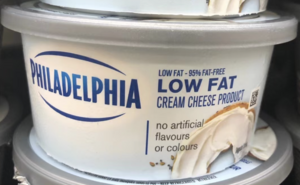
Pictures
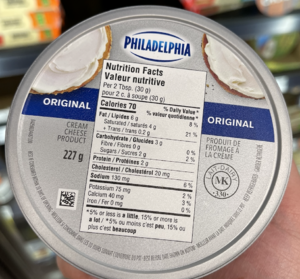


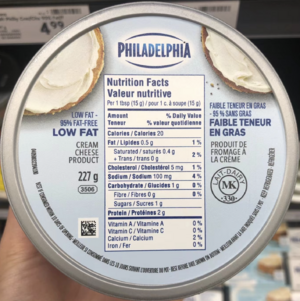
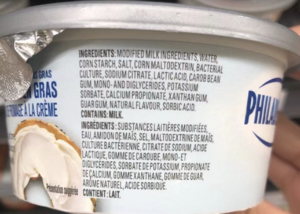

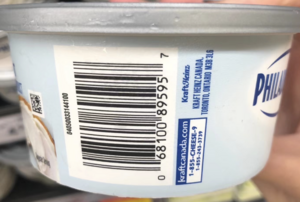
Ingredients
| Original[1] | Low Fat[2] |
|
|
Substitutes and Additives
| Original[1] | Low fat[2] | |
| Fat substitutes | None | Corn maltodextrin |
| Sugar substitutes | None | None |
| Additives |
|
|
Roles of Substitutes and Additives
[Fat substitutes]
- Corn maltodextrin is a carbohydrate based fat substitute, and helps maintain a similar light and creamy texture.[3]
[Sugar substitutes]
- None
[Additives]
- Sodium citrate is categorized under “pH adjusting agent, acid reacting material, and water correcting agents”. It is used to prevent fat particles from sticking to each other.[4]
- Calcium propionate is a food additive that acts as a preservative to prevent the growth of microorganisms.[5]
- Mono- and diglycerides are emulsifiers which improves the creamy texture and consistency of the product.[6]
- Xanthan gum is a polysaccharide produced by bacteria. It is used as a thickener and a low calorie fat substitute.[7]
- Guar gum is a polysaccharide based food additive that acts as a thickener, stabilizer, and emulsifier.[8]
- Carob bean gum is extracted from the seeds of the carob tree which acts as a thickener and stabilizer.[9]
- Potassium sorbate is commonly used as a preservative as it does not affect the taste, smell, or appearance of the product.[10]
- Sorbic acid is a preservative used to control the growth of microorganisms or oxidation in the food product.[11]
Compare and Contrast
| Ingredients in both products | Additional ingredients in low-fat product only |
|
|
All the ingredients contained in the original product are also included in the low-fat only product. However, the low-fat product contains many different additional ingredients. All of the additional ingredients are either fat substitutes or additives. As the low-fat product contains less fat and thus a different texture, these additives are used to help achieve a more creamy consistency that more closely resembles the original product while yielding less calories. First of all, in order to achieve low fat, corn maltodextrin, a carbohydrate based fat substitute, is added to reduce calories as well as producing a smooth and creamy mouthfeel. 1 gram of fat provides 9 kcal, whereas 1 gram of maltodextrin only yields 4 kcal.
Labels
| Philadelphia Cream Cheese - Original vs. Low Fat | |
| Common name of the food | Commonly known as Philadelphia Cream Cheese Original and Philadepia Cream Cheese Low-fat (Compliant) |
| Bilingual labeling | It contains both English and French labeling as it is by a Canadian company (Compliant) |
| Country of Origin | This is not required for dairy products produced in Canada, so it is not on the labels. (Compliant) |
| Date marking and storage instructions (if <90 days) | The best before date is labeled on the bottom of the box.
Products need to be refrigerated at all times. Shelf life is 10 days after opening. (Compliant) |
| Identity and Principal Place of Business | The principal place of business is Ontario, Canada. (Compliant) |
| Legibility and location | The information on the packaging is easy to read and the products is easily accessible in Canada (Compliant) |
| Net quantity | 227g is declared on the lid of both version of the product (Compliant) |
| Nutrition Facts table | The nutrition facts table contains all required elements such as calories, fat, sodium, carbohydrates, sugars, protein, and vitamin and mineral nutrients (Compliant) |
| List of ingredients (descending order of proportion) and allergens | List of ingredients are mentioned above, and can be seen in image 3.
Milk listed as allergen (Compliant) |
| Sweeteners | Included in the list of ingredients, as described above and can be seen in image 3. (Compliant) |
| Food additives | Included in the list of ingredients, as described above and can be seen in image 3. (Compliant) |
| Nutrient content claims and diet-related health claims | None on both products (Compliant) |
| % milk fat and moisture declarations | Not provided on label (non-compliant as both are required for cream cheese products) |
The information stated above complies with the regulatory requirements outlined in Lesson 4.
References
Please use the Wikipedia reference style. Provide a citation for every sentence, statement, thought, or bit of data not your own, giving the author, year, AND page.
- ↑ 1.0 1.1 "PHILADELPHIA CREAM CHEESE-SOFT ORIGINAL".
- ↑ 2.0 2.1 "PHILADELPHIA CREAM CHEESE-SOFT 95% FAT FREE LOW FAT".
- ↑ Judy, Chan (15 June 2022). "Types of Fat Substitutes". Canvas UBC.
- ↑ "List of Permitted pH Adjusting Agents, Acid-Reacting Materials and Water Correcting Agents". Canada. 14 April 2021.
- ↑ Raman, Ryan (15 July 2022). "Calcium propionate: Uses and safety". healthline.
- ↑ Carly, Vandergriendt (July 15 2022). "Monoglycerides: What are they and are they safe?". healthline. Check date values in:
|date=(help) - ↑ Chan, Judy (June 15 2022). "Carbohydrates". Canvas UBC. Check date values in:
|date=(help) - ↑ Link, Rachael (15 July 2022). "Is guar gum healthy or unhealthy? The surprising truth". healthline.
- ↑ Shoemaker, S (15 July 2022). "Locust bean gum: Uses, benefits, and safety". healthline.
- ↑ Hecht, M (15 July 2022). "Potassium sorbate: Uses, safety, and more". healthline.
- ↑ "List of Permitted Preservatives (Lists of Permitted Food Additives)". Canada. 10 June 2022.
| This Food Science resource was created by Course:FNH200. |
